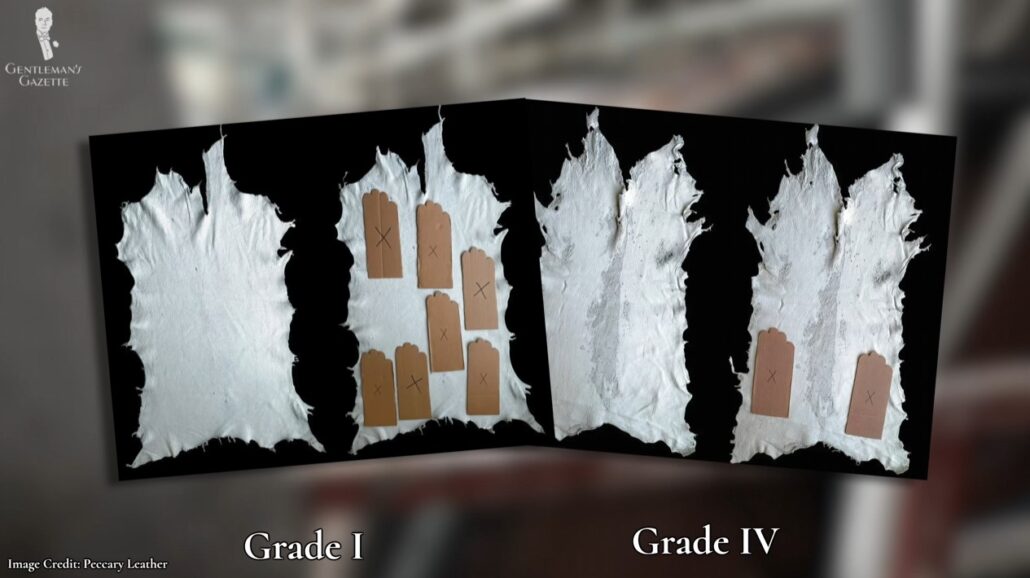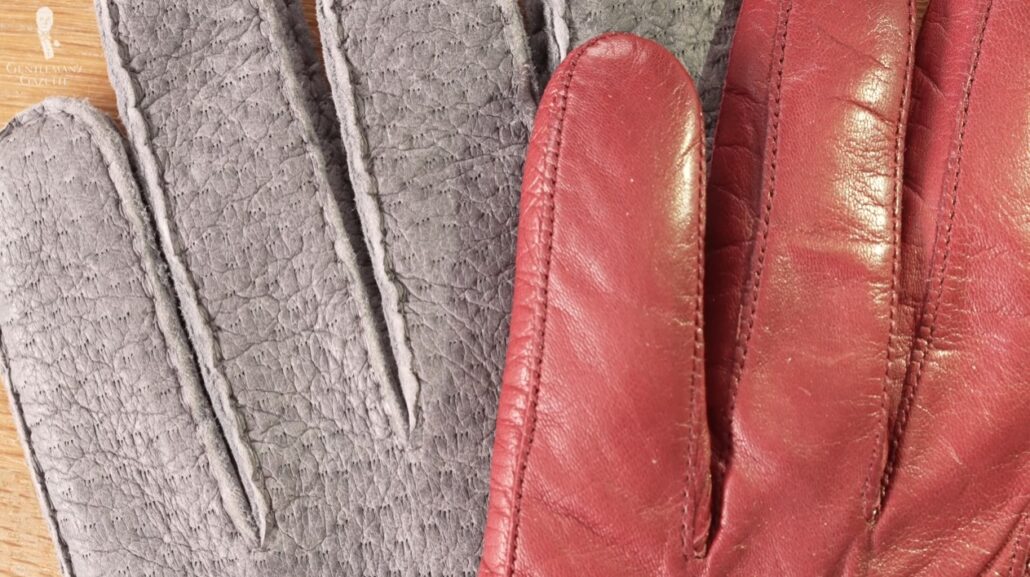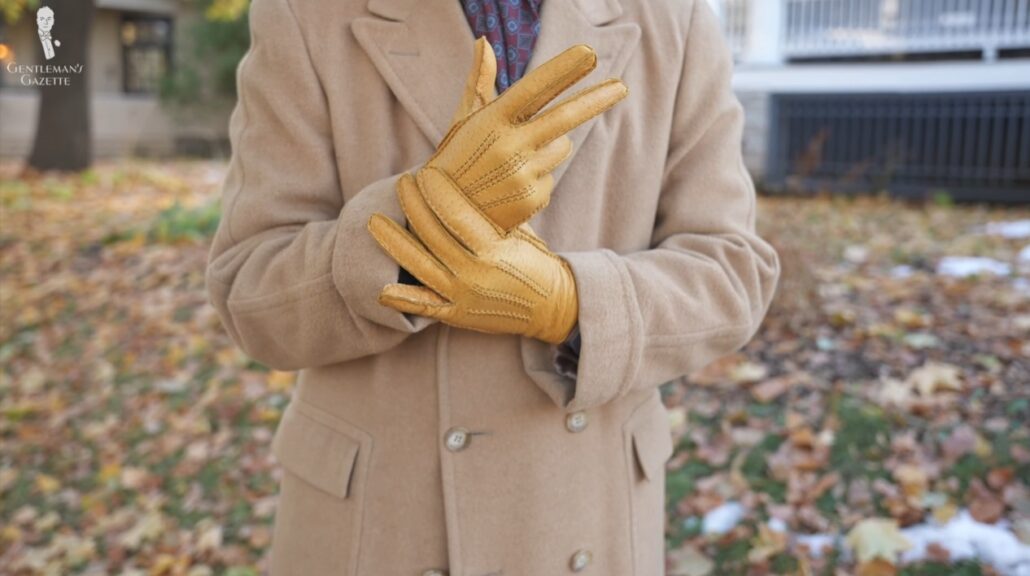You’ve probably heard about different types of leather, with used and exotic goods like alligator and crocodile being very expensive. But, there’s one kind of leather that’s becoming increasingly rare and, therefore, more expensive, and that’s peccary leather.
So, how expensive is peccary leather? Well, let’s consider that a typical pair of leather dress gloves are in the range of $30 to $60, and a pair of peccary leather gloves, try $300 to $400, and prices just keep going up from there. So, we’ll talk about how it’s made and why it’s so expensive.
What is Peccary Leather?
What is peccary leather, and where does it come from? Well, peccary leather comes from the peccary animal, which is a hoofed, pig-like animal reaching a minimum size of about 35 to 52 inches in length when fully grown.

While it might resemble a pig, they’re not actually part of the same family as peccaries come from the Tayassuidae family, and pigs are from the Suidae family. So, peccaries and pigs are closely related, which is why they look so much alike.
Unlike cattle, peccaries are not typically bred in a certain location like they are for the meat packing industry. Outside of a certain number of rare peccary hatcheries, they really have to be hunted in the wild.
To protect from overhunting and harvesting, there are some extremely strict regulations about how and where peccaries can be hunted. These regulations are set in place by CITES with the goal of ensuring a sustainable supply of hides that won’t damage the ecosystem. And, in fact, there’s only one place in the world where you can legally do this, and that’s Peru.

The fact the animals are either part of a sustainable hatchery or need to be hunted in a skilled, controlled manner, coupled with the knowledge that this can only be achieved in a very small part of the world, naturally makes the skin scarce, thus adding to the expense even before manufacturing begins.
How is Peccary Leather Made?
At this point, even though we’re going to talk about leather manufacturing, we’ll skip over all the gruesome details.
Harvesting

After a hunt, the peccary skins are harvested, and they look very different from what they will look like as the finished product. They’re still covered with hair. It actually looks more like a peccary rug than a pair of gloves.
Weighing & Removal of Hair
Next up, all the skins are weighed. This is important to make sure that they are tanned evenly. If there are too many skins that go through at the same time together, this will lead to an uneven yield. So, effectively, this means that only a small number of skins can go through and be tanned at a certain time. Because this is done in very small batch production, once again, it raises the prices and exclusivity.

Once the skins are correctly weighed, they are put in a vat of chemicals to remove the hair, and without this step, every single hair would have to be removed by hand. Peccary’s hair structure is very tough, and even if you tried to remove it by hand with a blade, you damage a large portion of the peccary skin. So, a chemical soak is needed at the right concentration to remove things properly and keep the skin safe.
Tanning
After the hair is removed, the leather is tanned in drums. And if you’ve seen our previous guide on cordovan leather, you’ll know that tanning is a long and arduous process. All leather is different and will require a different type of tanning process to achieve the desired outcome.
The blue-gray color of the leather here, for, example, is because the skins have been dyed with chromium salts. There’s often a debate on whether chrome tan or vegetable tan leather is better, and we have a guide for you about that topic.
Chrome Tanned vs. Vegetable Tanned Leather, Explained

Ultimately, chrome tan allows the peccary to maintain a soft and supple nature, but more on that later.
Shaving to Even-out Thickness
After the skins have been tanned, they’re shaved down to an even thickness. Because this is a natural material, there’s going to be some wonky and uneven parts. Shaving the skins down to an even depth means the peccary skins will be able to create high-quality products.
If this step didn’t happen, the skins would be too thick in some places for a needle and thread to pass through and may even render a finished garment unable to be used. This would mean a wasted skin as well as the peccary tannery potentially losing clients. So, this exact attention to detail has to be a part of the price for peccary. And even though the majority of hair would be removed between the chemical solution bath and the tanning process, there will be a few left, and they will be removed manually by hand during this stage.

Keep in mind that these hairs being removed by hand is a very time-consuming process. This process also requires an immense level of skill, as any slip of the hand would damage the skin.
Drying
Once the skins are clean and hair-free, they are left out to dry. Just like any other type of leather, this needs to happen away from sources of direct heat and sunlight so as not to distort the skins or risk drying them too quickly, making them brittle. And as I’m sure you can imagine, being near the equator, this step is easier said than done.

Grading
Once the skins are dry, they are graded on a scale of one to four. This is actually a very similar process to how products like alligator, crocodile, and silk are graded. So, effectively, one is the highest-quality grade with the least amount of blemishes, and four is the lowest quality that can still be used for manufacture.
The way that the grades are determined is by drawing a line vertically across the skin and then horizontally, breaking it up into four quadrants. Then, based on how many defects are in each of the quadrants, the skin will receive its grade.
For a hide to be a grade-one quality, there have to be no defects in any of the four quadrants. This is something that is extremely rare, considering that this comes from a wild animal and it’s rare for there to be no defects. A grade one peccary skin is highly-desired by leather manufacturers because they can make more products with one skin.

If you look at this picture of this grade one skin, you can see how many pairs of gloves can actually be made, whereas this image of a grade four leather shows just how few gloves can be made. Therefore, a leather manufacturer has to pay a high price in order to get really good skins or, on the alternative, they have to buy a larger quantity of lower grade skins. The overall manufacturing process is very impressive, which leads to why it is so expensive.
Peccary Leather Properties
Let’s now take a deeper dive into the qualities of peccary leather. Because peccary leather commands such high prices, it’s important to really know what you’re looking at so you can make an informed buying decision.
There is a thing called imitation peccary, and it’s regular calfskin that’s made to look peccary. It is worth noting that a reputable outlet should make it very clear what imitation peccary is, but if you’re looking for a pair of secondhand gloves or vintage gloves, you should know what you’re looking for.
1. Scars or blemishes

The first thing that you should be aware of is the fact that pecker leather might have small defects. After all, this comes from an animal with very sharp teeth and tusks, so whether it’s a disagreement with a fellow peccary or a scar from a predator, you can expect these skins to have natural blemishes. And while other forms of leather might be thrown out due to imperfections, the true connoisseur of peccary really likes these unique charms and imperfections.
2. Three-pronged pores
The other big visual giveaway for genuine peccary leather is the distinct, three-pronged pore structure that is visible throughout the skin. After all, those stubborn hairs have been removed, leaving a signature pattern of three closely-grouped pores throughout the hide. This is exactly the feature that’s often seen on lower-priced gloves, too, as well as imitation peccary that we mentioned earlier. Because the pattern of authentic peccary pores can be replicated onto a large metal stamp that is pressed onto a lower grade of leather, the peccary look can be achieved at a greatly reduced cost.

Three-pronged Pore Structure
A big visual giveaway for genuine peccary is the distinct three-pronged pore structure that is visible through the skin.
As long as imitation peccary is marketed as such, there’s really nothing wrong with it, but it’s not the same as real peccary. Plus, you run the risk of people thinking you are a fake by wearing imitation goods.
3. Matte finish
Another telltale characteristic of peccary is the matte finish. Unlike other leathers, peccary isn’t shiny. In fact, it’s very matte and almost has a chalky appearance. In fact, this is the one thing that imitation peccary can’t do, as heat and pressure from metal stamps will make a different type of leather look very shiny.

4. Soft, supple feel
Along with the matte finish comes a very soft and supple feel, peccary leather is naturally quite elastic and stretchy in its nature. This means that you can pull a piece of peccary leather and watch it relax again in a similar way to if you were to pinch the skin on your own arm. This elasticity can feel quite spongy against the skin when peccary leather is in its natural state, which can be quite comfortable to wear.

5. Remarkably durable
You’d also be very surprised at how durable peccary leather is. For a hide that’s as soft and supple as it is, peccary usually has to be cut or punctured before it tears, meaning it won’t wear down in spots like other leathers would.
What this does mean is that peccary quite often has to be hand-sewn, especially when being made into gloves. Simply put, a human hand and handiwork can really judge the amount of pressure that needs to go into the stitches at different flexing points for a pair of gloves. This is truly an art, as it can take years to learn the skills necessary to make a pair of peccary gloves, and one skilled craftsperson can spend up to six hours making one pair.

6. Takes on a new look throughout time
Given its natural longevity, you’ll be able to wear peccary gloves for years to come, and they will develop a really nice, unique patina.
If you like products to take on a unique look as they age, this shouldn’t be a problem for you. But if you want something that looks bright and shiny every time you wear it, peccary leather might not be for you.

Also, peccary leather is the only leather that can be washed, so if you want to clean them up after maybe shoveling some snow, peccary leather is an option that can be washed.
Best Uses For Peccary
To wrap up, let’s take a look at what peccary is best used for. Given what we’ve discovered about peccary today, it shouldn’t be a surprise that due to the overall small size of the skins, peccary leather isn’t good for larger items or garments such as jackets or furniture. Never say never, but the resulting items would have to be patchworked together from several different pieces of peccary skins, which just wouldn’t look elegant in any way.

Gloves
Peccary isn’t good for larger items or garments. They are most popularly used for gloves.
Considering this is a Gentleman’s Gazette content, the most popular usage for peccary is in leather gloves. Wallets, watches, straps, key rings, business card cases, and the like are candidates for perfect peccary use as they allow for single pieces to be cut from the peccary hides without having to patchwork things together. For this reason, belts are particularly difficult to make in peccary leather, as two or more pieces typically have to be cut to make a long belt.
It is possible to find peccary’s shoes, but these typically have to be made from thicker, harder hides, which does lose some of the peccary characteristics. Instead, you’re more likely to see peccary used in conjunction with other leathers, like on two-tone shoes or Balmoral boots.
Conclusion
As we conclude our journey of discovering more about peccary leather, it’s easy to see why this product is so expensive. The manufacture of peccary leather is done on an extremely small scale, and it’s highly regulated. Great care must be taken throughout the manufacturing process to ensure the best possible grade of hide is achieved. Even then, multiple hides will likely be required to make peccary leather goods.

Once the leather arrives at a leather goods maker, it requires a lot of skill and handiwork in order to create the end product. The skills required to make those products is an investment in skilled craftsmanship, which takes longer and more time to produce that product than a churned-out, fast fashion piece.
If you take care of your peccary leather goods, you likely won’t have to replace them, meaning a retailer of peccary items isn’t basing their business on a repeat customer. Instead, they’re looking for connoisseurs that not only enjoy high-quality products but also appreciate their value in every way.
So, with everything that we’ve discovered today, what is your take on peccary leather? Regardless of if you’re a newcomer and you’ve never heard of peccary leather or if you own 15 pairs of gloves, we would love to hear your comments down below.
Outfit Rundown

Today, I’m wearing an outfit that’s perfect for early fall in Minneapolis. It consists of a green field jacket that I got from Nordstrom, a denim shirt that’s made-to-measure by Beckett & Robb, a pair of tan chinos, and a pair of classic Wolverine 1000 Mile work boots.
On my wrist is this cool IWC Mark XVIII Pilot’s Watch. This was sent over by our friends over at Delray Watch. They’re not a sponsor, but they send us watches, and we certainly love wearing them.
Also, I have a couple of pairs of peccary gloves. These are ones that we carry at Fort Belvedere. It’s not quite cold enough here in Minneapolis to start wearing them yet, but we decided to show them off because we love making them. If you need any other products for this early fall, such as a pair of brown socks, maybe an orange pocket square or if you want to get a jump start on picking up some peccary gloves, you can take a look at the Fort Belvedere shop.


peccaries over breed and ruin ecosystems. they are a nuisance.
contradicts your article’s statements.
ps
I love your channel. Let’s have a expose why you can’t find spectators in wide widths.
Thank you for your support, Emilio!
Perhaps you mean the Collared Peccary, or as it’s commonly known, the Javelina? While these are more widespread than the vulnerable White-Lipped Peccary and the endangered Chacoan Peccary, hunting them is still regulated.
Spectators can be found in wider widths, but you will likely have to go made-to-order to get the right width for you. High-quality manufacturers such as Edward Green typically offer such a service.
Love the video and article. I carry the peccary shoes from Scarpe di Bianco and will enjoy telling our clients more about the background and sourcing of peccary. If I heard you correctly you actually “make” your peccary gloves for your store? I would be interested in carrying them at my store in Houston, TX. Check out our website at http://www.bkrepsco.com
Will anyone be at the Chicago market in February.
I would love a pair of the red with blue trim stitching that you show in the video for myself to wear to Chicago.
Brian Kreps
b.Kreps&Co.
brian@bkrepsco.com
314-480-2344
I love my peccary gloves and look forward to wearing them in colder weather (one good thing about the weather).
I’m right there with you, Erik! I have a pair of Fort Belvedere Grey Peccary gloves lined in cashmere, and am looking forward to chillier days in the UK just so I can wear them!
What are your Peccary gloves like, and how do you like to pair them?
I bought a Cashmiere lined and unlined pair of Dents black Peccary gloves with snaps based on the video that Sven did.
I am pleased that I watched it because it was very informative. I love my gloves.
This was a thorough and informative video.